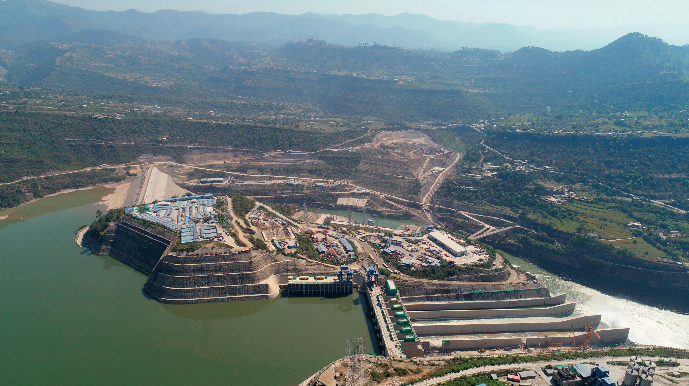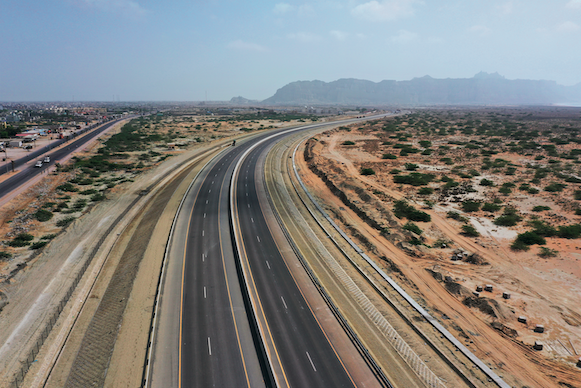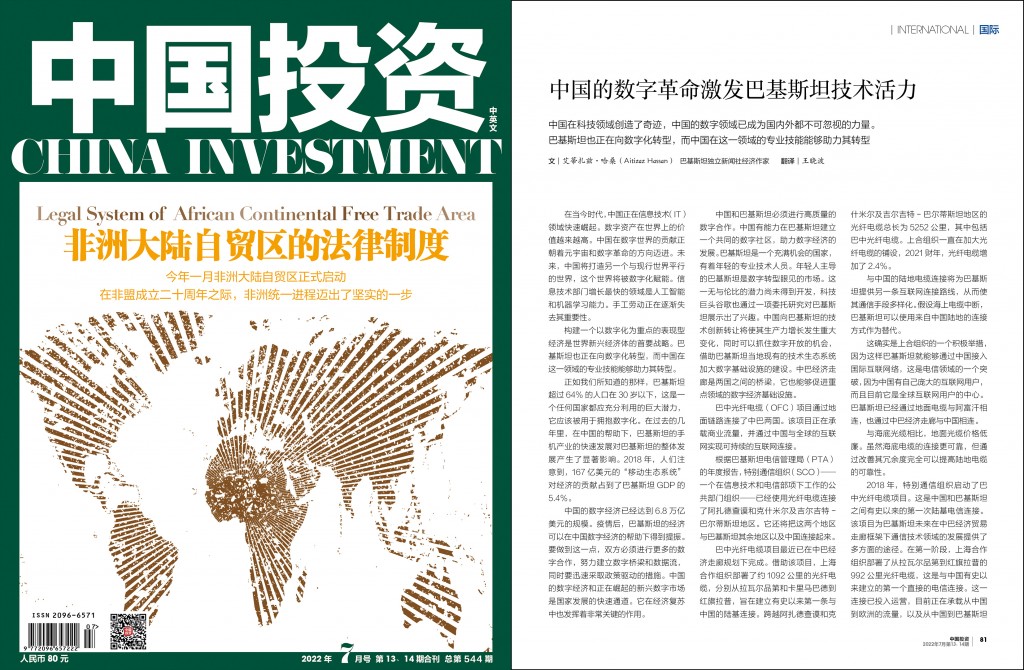By Aitizaz Hassan, Independent News Pakistan, Economic writer
文|艾蒂扎兹·哈桑(Aitizaz Hassan) 巴基斯坦独立新闻社经济作家 翻译|王晓波
导读

⬆ On April 7, 2022, Pakistan Karot Hydropower Station, the first hydropower investment project in the China Pakistan Economic Corridor mainly invested and developed by China Three Gorges Group (Xinhua news agency, provided by China Three Gorges Group)
In this era the china is rising industry in the world of Information Technology (IT). The digital assets are getting more worth in world. The contribution of china in digital world is stepping toward metaverse and digital revolution. In future, China is going to shape another world parallel to this world which will be digitally empowered. The most growing area of IT sector is artificial intelligence and machine learning. The manual effort is falling its importance.
Structure an expressive economy with a focus on digitalization is a top priority strategy for emerging economies in the world. Pakistan has the same paradigm shift towards digitalization and Chinese expertise in this field could speed up digital transformation.
As we see that more than 64% population in Pakistan is under the age of 30, it is a perfect potential for any country to relish this advantage. This massive potential can be used for digital embracing. In the last few years, with the help of China, the mobile phone industry has grown in Pakistan. This rapid growth has had a clear impact on the overall development of Pakistan. In 2018, it was noticed that $16.7 billion “Mobile Ecosystem” has contributed to the economy which is equivalent to 5.4% of the country’s GDP.
China’s digital economy already stretched to $6.8 trillion. In the post-pandemic, Pakistan’s economy can be boosted with China’s Digital economy help. To reach this point there must be more digital cooperation, efforts for creating a digital bridge, the flow of data, and other policy-driven steps need to be taken swiftly. China’s digital economy and new digital emerging market is a fast-progressive way for the country’s growth. It is playing a very crucial role in the economic recovery as well.
China and Pakistan must take high-quality digital cooperation. China is in a position to build a mutual digital community in Pakistan for a digital economy boost-up. Pakistan is a land of opportunity with young skilled professionals. Youth-oriented Pakistan is the discoverable marketplace for digital transformation. This unmatched potential is untapped and a Tech Giant Google has shown its interest too by a commissioned research study. China’s technologies innovations transfer to Pakistan will bring a major change in productivity growth, capture digital open-door opportunities, develop digital infrastructure with the help of Pakistani local existing technological ecosystem. CPEC is a bridge between both countries to promote a digital economy infrastructure with focused areas.
Pak-China Optical Fiber Cable (OFC) Project is connecting China and Pakistan through terrestrial links. The project is carrying commercial traffic and booming a sustainable internet linking with global network via China.
According to Pakistan Telecommunication Authority (PTA) Annual report, Special Communication Organization (SCO) -a public sector organization working under Ministry of Information Technology and Telecommunication- has connected Azad Jammu Kashmir (AJ&K) and Gilgit Baltistan (GB) with Optical Fiber Cable (OFC). It also connects AJK and GB with rest of the country and with China.
The Pakistan-China OFC project has recently been completed under the China-Pakistan Economic Corridor (CPEC) program. Under this project, SCO has deployed approximately 1,092 kilometers of OFC from Rawalpindi to Khunjerab, and Karimabad to Khunjerab to establish the first-ever land-based connection with China. The total length of OFC laid across AJ&K and GB, inclusive of the Pak-China OFC, is 5,252 kilometers. SCO is consistently increasing its OFC, which grew by 2.4% during FY 2021.
The land cable connection with China will provide an alternate route of internet connection to Pakistan and diversify the means of communication. suppose if there is a disruption in sea cable, Pakistan will consume the substitute connection from a different rout in the shape of land connection from China.
It is indeed a positive move by SCO because by this Pakistan will enjoy access to International network via china. it will be a breakthrough in telecommunication because China’s internal internet users are in millions and currently it is a global hub of internet users. The optical fiber cable is usually use where there is land lock between two countries. Pakistan is already connected with Afghanistan through terrestrial cable and also with China through China Pakistan Economic Corridor (CPEC).
The terrestrial cable is inexpensive as compare to sea fiber cable. although sea cable is more reliable connection but you can improve the reliability factor of land cable by improving its redundancy.
The Special Communication Organization (SCO) initiated the Pak-China OFC project in 2018. This is the first-ever land-based telecommunication connection between China and Pakistan. The project has multidimensional avenues for future Information Communication and Technology (ICT) developments in CPEC trade corridor in Pakistan.
Under Phase-I, SCO has deployed 992 kilometers of OFC from Rawalpindi to Khunjerab and has established the first-ever direct telecom connectivity with China.
The link is operational and currently carrying traffic from China to Europe, courtesy the, and from China to Pakistan for CMI- Zong connectivity. In the meanwhile, negotiations are underway with Chinese operators for higher volumes of traffic for different international destinations in the Middle East, Africa, and Europe. Phase-II of the project encompasses the planned extension of OFC network from Rawalpindi to Karachi and Gwadar.
The soft launch of the project in Gilgit on April 30, 2021. This phase will also see SCO deploying OFC from Rawalpindi to Gwadar and Karachi along CPEC routes, along with establishing a landing station at Gwadar. The project will cost $ 236.9 million (PKR 37.9 billion), of which 15% has been appropriated for local component and 85% for foreign exchange component (FEC).
The project will create a national ICT infrastructure, thereby reducing reliance on foreign infrastructure. It will additionally provide regional connectivity between China and neighboring Afghanistan and Iran, thereby making Pakistan the hub of regional connectivity. Moreover, the project forges broad strategic and socio-economic dimensions in addition to the synergy created by meeting the ICT requirements of Pakistan Railways and the National Highway Authority (NHA) through unified networks.
China Mobile Pakistan (Zong) is also expanding its digital penetration in Pakistan by fixing the special network arrangements around the different projects of China Pakistan Economic Corridor (CPEC). Zong has developed 18 dedicated Internet access (DIA) on CPEC route, which is designed for businesses that need a greater internet capacity and a secure dedicated connection between their existing Local Area Network (LAN).
Zong 4G is playing the role of the primary connectivity provider in CPEC projects with its unmatched network footprint and high-speed data products and services, which accelerated digital penetration in the country.
Zong is becoming the backbone of connectivity for Belt and road initiative (BRI) and China Pakistan Economic Corridor. It aims to promote the communication across Pakistan through a network of highways, railways, and pipelines in addition to energy, industrial, and other infrastructure development projects.
Zong 4G’s owned by China mobile working day and night to night to set up a 4G network at Thar coal project. Zong 4G is now an active contributor around Thar Coal project with dynamic communication network from the project’s side. Thar Coal is one of the CPEC’s key projects, which is located in the desert of Sindh province with no network coverage.
Zong has also enabled its digital services at CPEC projects. Zong 4G is currently providing Information Communication and Technology (ICT) services at Karakorum Highway (KKH) Phase II, Karot Hydro Project, Suki Kinari Hydro Project, Dawood Wind Power, Port Qasim, HUBCO Coal Power Plant, Sahiwal Coal Power Plant, and Zonergy Solar Projects. It includes the Services of Smart phone for users, mobile broad band (MBB), Wi-Fi Devices and Customer Acquisition Platform to small business.
During the fiscal year 2020-2021, Zong has increased its subscribers in Azad Jammu and Kashmir and Gilgit Baltistan, which is an essential area of China Pakistan economic corridor. According to PTA 1 million mobile subscribers has been added in Zong network during 20-21 Fiscal year in AJ&K and GB. Similar, Zong has added 509,118 broadband subscribers and fix 386 cell towers at AJ&K and GB in 20-21 Fiscal year. 40 million mobile consumers have joined the Zong network in the country during FY 20-21, while 2.7 million of internet users have joined the broadband service of Zong in the country during same period.
It is priority of Zong to strengthen the connectivity for CPEC project as well as between the people of China and Pakistan. Zong 4G’s unrivaled data connectivity, the region is expected to receive significant economic uplift. it will also help immensely in further to promote tourism in Pakistan and will also support the connectivity for CPEC projects.
Zong 4G has become the only network to offer unlimited calls to China to make international direct dialing to China more convenient. Zong 4G has also launched special call bundles for China. The China bundles have been developed to suit both pre-paid and post-paid customers and will provide ease to both private and business customers by enabling calls to China at the lowest rates in the industry.
Similarly, the globally famed Chinese tech firm Huawei and Pakistan Software Export Board (PSEB) agreed to work together in cloud computing cooperation. Huawei will enable its cloud service in all the affiliated public department related to Information Technology (IT) and IT enabled Services (ITeS) of PSEB at subsidized rates.
Huawei and Pakistan Software Export Board (PSEB) recently signed a contract to offer cloud services to the IT industry of government of Pakistan, which will enable digital transformation in the public sector in Pakistan.
Recently, Huawei and Pakistan Telecommunication Company Limited (PTCL) also launched the PTCL-Huawei Managed cloud Campus Solution with which enterprises will be empowered to run critical applications with complete security and ensured data privacy at their disposal. Not only so, but enhanced performance will also be delivered with higher capacity bandwidth, network visibility, and a seamless on-ramp to the cloud with significant application performance.
Huawei Cloud is the world’s fastest growing major cloud service provider and continues to empower industries. it has launched more than 220 cloud services and 210 solutions, and attracted over 30,000 partners and 2.6 million developers worldwide. More than 6,100 applications are now available on the Huawei Cloud marketplace.
Pakistan is a very lucrative market for International firms that’s why more IT company are galloping to Pakistan. The digital service providers in Pakistan serve to international entrepreneurs on very reasonable cost. Pakistan digital market isn’t only cheaper but provides a more reliable operations as compare to other markets.
Suppose, if an international firm is paying 1000 dollar to other market, the cost of same service can be 50% lesser in Pakistan. therefore, various International companies sublet their services in Pakistan. Many Pakistani Fiverr and Upwork account holders are serving to international world because of their reasonable cost and quality work.
Another framework of China Pakistan digital cooperation is Special Technology Zone Authority (STZA) of Pakistan. STZA is inviting 4,000 Chinese technology firms to Pakistan in August 2022 to work on IT cooperation.
Pakistan has developed a multi-pronged strategy with Chinese tech stakeholders. The Foreign Office of Pakistan has a special section for Chinese affairs, while the STZA has introduced a comprehensive strategy with Pakistani embassy in China about outreach of Chinese businesses.
Pakistani Ambassador to China Moinul Haq has engaged 200 Chinese companies by sending invitation letters to them.
Chinese companies take a keen interest in the STZA plans. China has announced a $400 billion plan on semi-conductors in chip designing technology. China needs 0.5 million chip developers — 0.2 million designers are available internally in China, while it is looking for 0.3 million designers in other countries. Pakistan is also engaged with China to provide chip designing services. This strategic cooperation is being negotiated an agreement level.
STZA is also part of Joint Working Group of China-Pakistan Economic Corridor (CPEC) which is organized under the Ministry of Information Technology. Pakistan is going to make an official agreement with Z-Park in Beijing in September 2022. Under that agreement, a China-Pakistan Technology Center will be built in both countries as a joint venture.
STZA is in touch with the Pakistan embassy in China. Technology cooperation with Chinese tech sector is a priority of Pakistani embassy in China. The STZA also shared a cooperation framework with science counselor of Chinese embassy in Islamabad about the capacity building of government officials in IT learning.
China has worked wonders in the technology world. Pakistan is working to cooperate in knowledge transfer and exchange. The STZA also wants to learn about China’s public policy.https://www.app.com.pk/global/chinese-pakistani-scholars-propose-cpec-digital-transformation-center/
China has become a force to be reckoned with in digital at home and around the world. As a major worldwide investor in digital technologies and one of the world’s leading adopters of such technologies, it is already shaping the global digital landscape and supporting and inspiring entrepreneurship far beyond its own borders.
在当今时代,中国正在信息技术(IT)领域快速崛起。数字资产在世界上的价值越来越高。中国在数字世界的贡献正朝着元宇宙和数字革命的方向迈进。未来,中国将打造另一个与现行世界平行的世界,这个世界将被数字化赋能。信息技术部门增长最快的领域是人工智能和机器学习能力。手工劳动正在逐渐失去其重要性。

⬆ 2022年6月3日,中国援助巴基斯坦瓜达尔东湾快速路举行通车仪式,标志着瓜达尔港区对外连接道路正式打通(新华社记者 蒋超摄)
构建一个以数字化为重点的表现型经济是世界新兴经济体的首要战略。巴基斯坦也正在向数字化转型,而中国在这一领域的专业技能能够助力其转型。
正如我们所知道的那样,巴基斯坦超过64%的人口在30岁以下,这是一个任何国家都应充分利用的巨大潜力,它应该被用于拥抱数字化。在过去的几年里,在中国的帮助下,巴基斯坦的手机产业的快速发展对巴基斯坦的整体发展产生了显著影响。2018年,人们注意到,167亿美元的“移动生态系统”对经济的贡献占到了巴基斯坦GDP的5.4%。
中国的数字经济已经达到6.8万亿美元的规模。疫情后,巴基斯坦的经济可以在中国数字经济的帮助下得到提振。要做到这一点,双方必须进行更多的数字合作,努力建立数字桥梁和数据流,同时要迅速采取政策驱动的措施。中国的数字经济和正在崛起的新兴数字市场是国家发展的快速通道。它在经济复苏中也发挥着非常关键的作用。
中国和巴基斯坦必须进行高质量的数字合作。中国有能力在巴基斯坦建立一个共同的数字社区,助力数字经济的发展。巴基斯坦是一个充满机会的国家,有着年轻的专业技术人员。年轻人主导的巴基斯坦是数字转型眼见的市场。这一无与伦比的潜力尚未得到开发,科技巨头谷歌也通过一项委托研究对巴基斯坦展示出了兴趣。中国向巴基斯坦的技术创新转让将使其生产力增长发生重大变化,同时可以抓住数字开放的机会,借助巴基斯坦当地现有的技术生态系统加大数字基础设施的建设。中巴经济走廊是两国之间的桥梁,它也能够促进重点领域的数字经济基础设施。
巴中光纤电缆(OFC)项目通过地面链路连接了中巴两国。该项目正在承载商业流量,并通过中国与全球的互联网实现可持续的互联网连接。
根据巴基斯坦电信管理局(PTA)的年度报告,特别通信组织(SCO)——一个在信息技术和电信部项下工作的公共部门组织——已经使用光纤电缆连接了阿扎德查谟和克什米尔及吉尔吉特-巴尔蒂斯坦地区。它还将把这两个地区与巴基斯坦其余地区以及中国连接起来。
巴中光纤电缆项目最近已在中巴经济走廊规划下完成。借助该项目,上海合作组织部署了约1092公里的光纤电缆,分别从拉瓦尔品第和卡里马巴德到红旗拉普,旨在建立有史以来第一条与中国的陆基连接。跨越阿扎德查谟和克什米尔及吉尔吉特-巴尔蒂斯坦地区的光纤电缆总长为5252公里,其中包括巴中光纤电缆。上合组织一直在加大光纤电缆的铺设,2021财年,光纤电缆增加了2.4%。
与中国的陆地电缆连接将为巴基斯坦提供另一条互联网连接路线,从而使其通信手段多样化。假设海上电缆中断,巴基斯坦可以使用来自中国陆地的连接方式作为替代。
这确实是上合组织的一个积极举措,因为这样巴基斯坦就能够通过中国接入国际互联网络,这是电信领域的一个突破,因为中国有自己庞大的互联网用户,而且目前它是全球互联网用户的中心。巴基斯坦已经通过地面电缆与阿富汗相连,也通过中巴经济走廊与中国相连。
与海底光缆相比,地面光缆价格低廉。虽然海底电缆的连接更可靠,但通过改善其冗余度完全可以提高陆地电缆的可靠性。
2018年,特别通信组织启动了巴中光纤电缆项目。这是中国和巴基斯坦之间有史以来的第一次陆基电信连接。该项目为巴基斯坦未来在中巴经济贸易走廊框架下通信技术领域的发展提供了多方面的途径。在第一阶段,上海合作组织部署了从拉瓦尔品第到红旗拉普的992公里光纤电缆,这是与中国有史以来建立的第一个直接的电信连接。这一连接已投入运营,目前正在承载从中国到欧洲的流量,以及从中国到巴基斯坦的中国移动与中国移动巴基斯坦公司的连接。与此同时,与中国运营商的协商正在进行,旨在提高中东、非洲和欧洲不同国际目的地的流量。该项目的第二阶段包括将计划中的光纤电缆网络从拉瓦尔品第延伸至卡拉奇和瓜达尔。
2021年4月30日,该项目在吉尔吉特开始试运营。接下来将看到上合组织沿中巴经济走廊部署从拉瓦尔品第到瓜达尔和卡拉奇的光纤电缆,并在瓜达尔建立一个着陆站。该项目将耗资2.369亿美元(相当于379亿巴基斯坦卢比),其中15%是本币,85%是外汇。该项目将打造属于巴基斯坦的信息通讯技术的基础设施,从而减少对外国基础设施的依赖。它还提供了与中国和邻国阿富汗和伊朗之间的区域连接,使巴基斯坦成为区域连接的枢纽。此外,统一网络也满足了巴基斯坦铁路和国家公路局对信息通讯技术的要求,在广泛的战略和社会经济层面形成了协同发展。
中国移动旗下的中国移动巴基斯坦公司(Zong)通过固定中巴经济走廊框架下不同项目的特殊网络安排,扩大了其在巴基斯坦的数字投资。它还在中巴经济走廊沿线开发了18个专用互联网接入,这是为需要更大互联网容量和与现有的局域网安全连接的企业专门设计的。
中国移动巴基斯坦公司的4G网络覆盖率和高速的数据产品及服务都是无与伦比的,在中巴经济走廊项目中扮演着主要连接提供商的角色,这也加快了它在巴基斯坦的数字发展速度。
中国移动巴基斯坦公司正在成为“一带一路”倡议和中巴经济走廊在互联互通方面的中坚力量。它旨在通过公路、铁路和管道网络以及能源、工业和其他基础设施开发项目,促进巴基斯坦全国的通信能力。
中国移动巴基斯坦公司正在夜以继日地工作,为塔尔煤炭项目建立4G网络。它的4G动态通信网络已经成为塔尔煤炭项目的积极贡献者。塔尔煤矿是中巴经济走廊的关键项目之一,位于信德省的沙漠中,没有网络覆盖。
中国移动巴基斯坦公司还为中巴经济走廊项目提供了数字服务。它的4G网络目前正在为喀喇昆仑公路二期、卡洛特水电项目、Suki Kinari水电项目、Dawood风力发电、卡西姆港、HUBCO煤电厂、Sahiwal煤电厂和Zonergy太阳能项目提供信息通信和技术服务。
在2020-2021财政年度,中国移动巴基斯坦公司在阿扎德查谟和克什米尔及吉尔吉特-巴尔蒂斯坦地区的用户数量一直在增加,这是中巴经济走廊的重要地区。根据巴基斯坦电信管理局的统计,2020-2021财年,中国移动巴基斯坦公司在这两个地区的移动用户已经增加到100万。在同一时期,它还在这两个地区增加了509118个宽带用户,并安装了386个基站。在这一财年,巴基斯坦全国有4000万手机用户用上了中国移动巴基斯坦公司的网络,270万互联网用户使用了其提供的宽带服务。
中国移动巴基斯坦公司的首要任务是加强中巴经济走廊项目以及中巴两国人民之间的互联互通。凭借中国移动巴基斯坦公司无与伦比的数字联通性,巴基斯坦有望在经济上获得显著提升。它还将极大地促进巴基斯坦旅游业的发展,并支持中巴经济走廊项目的联通性。
中国移动巴基斯坦公司已成为唯一一个向中国提供无限通话的网络,并且使国际直拨中国的业务更加方便。中国移动巴基斯坦公司的4G网络还推出了与中国通话的特别通话捆绑包。这个捆绑包的开发既适合预付费客户,也适合后付费客户,通过以业内最低的费用拨打中国电话,为私人和商业客户提供了便利。
与之类似的是,全球知名的中国科技公司华为和巴基斯坦软件出口局也同意在云计算领域展开合作。华为将在所有与信息技术相关的附属公共部门启用其云服务,并以补贴费率为巴基斯坦软件出口局提供信息技术支持服务。
华为和巴基斯坦软件出口局(PSEB)最近签署了一项合同,华为将向巴基斯坦政府的信息技术行业提供云服务,这将有助于巴基斯坦的公共部门实现数字化转型。
最近,华为和巴基斯坦电信有限公司(PTCL)还推出了由它们共同管理的云校园解决方案。通过该解决方案,企业将有权运行关键应用程序,它不仅具有绝对的安全性,而且能够确保由企业支配的数据隐私。此外,通过更高的容量带宽、网络可视性和无缝接入平台,企业的使用性能和应用程序性能也得到了增强。
华为云是世界上增长最快的主要云服务提供商,并一直在为各行业提供支持。它已经推出了220多个云服务和210个解决方案,在全球范围内吸引了30000多个合作伙伴和260万名开发人员。华为云市场目前有6100多个应用程序可供使用。
巴基斯坦对国际公司来说是一个非常有盈利机会的市场,这就是为什么越来越多的信息技术公司正快速前往巴基斯坦的原因。巴基斯坦的数字服务提供商以非常合理的成本为国际企业家们服务。而且与其他市场相比,巴基斯坦的数字市场不仅更便宜,而且提供的运营也更可靠。
假设一家国际公司在其他市场需要支付1000美元,那它在巴基斯坦的支出可以降低50%。因此,多家国际公司将其服务业务转包给了巴基斯坦。许多巴基斯坦Fiverr和Upwork的账户持有人因其合理的成本和高质量的工作正在为世界提供服务。
中巴数字合作的另一个框架是巴基斯坦特别技术区管理局(STZA)。它正在邀请4000家中国技术公司2022年8月到巴基斯坦进行信息技术合作。
巴基斯坦与中国的技术利益相关者制定了一项多管齐下的战略。巴基斯坦外交部设有专门负责中国事务的部门,而特别技术区管理局已向巴基斯坦驻华大使馆就中国企业的对外拓展提交了一项全面战略构想。
巴基斯坦驻华大使莫伊努尔·哈克已经向200家中国公司发出了邀请信。
中国公司对特别技术区管理局的计划非常感兴趣。中国已经宣布了一项4000亿美元的有关半导体芯片设计技术的计划。中国需要50万名芯片开发人员——在中国国内有20万名设计师,因此还需要在其他国家寻找另30万名设计师。巴基斯坦还参与了为中国提供芯片设计的服务。这一战略合作正在协议层面进行谈判。
特别技术区管理局也是信息技术部下属的中巴经济走廊联合工作组的成员。巴基斯坦将于2022年9月在北京就中关村科技产业园达成正式协议。根据这项协议,中巴将以合资企业的形式在两国建立一个技术中心。
特别技术区管理局一直与巴基斯坦驻华大使馆保持着联系。与中国科技部门的技术合作是巴基斯坦驻华大使馆的优先事项。特别技术区管理局还与中国驻伊斯兰堡大使馆的科技参赞分享了一个关于政府官员信息技术学习能力建设的合作框架。
中国在科技领域创造了奇迹。巴基斯坦正在努力在知识转让和交流方面与中国展开合作。特别技术区管理局还希望更多地了解中国的公共政策。
中国的数字领域已成为国内外都不可忽视的力量。作为全球数字技术的主要投资者和世界领先技术的采用者,中国不仅在打造全球数字景观,而且也在支持和激励超越其国界的创业精神。



